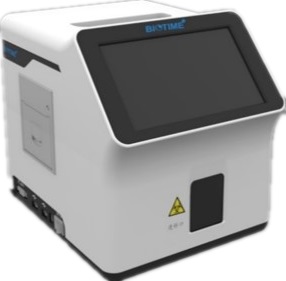What is Chemiluminescent Immunoassay
Chemiluminescent immunoassay (CLIA) is an immunoassay technique where the label, i.e. the true “indicator” of the analytic reaction, is a luminescent molecule. In general, luminescence is the emission of visible or near-visible radiation which is generated when an electron transition from an excited state to a ground state. The resultant potential energy in the atom gets released in the form of light. (Cinquanta, Fontana and Bizzaro, 2017) Chemiluminescent immunoassays offer one of the best solutions for the quantification of low concentrations of specific analytes from a complex mixture for in vitro diagnostic industry. They can also be used as diagnostic tools in medicine, as well as being used in several other different industries for various applications. (Lorne Laboratories, 2021)
How Does Chemiluminescence Work
Chemiluminescence immunoassay (CLIA) is an assay that combines the chemiluminescence techniques with immunochemical reactions. The assay format is similar to enzyme-linked immunoassays, usually based on heterogeneous assays where antibodies or antigens are immobilized on a solid phase but one of the components is conjugated with a chemiluminescent label. (Lorne Laboratories, 2021) (BrightTALK, 2021) CLIA utilizes chemical probes which could generate light emission through a chemical reactions to label the antibody. (Creative-diagnostics, 2021)
The Benefits of Chemiluminescence Immunoassay
In recent years, CLIA has gained increasing attention in different fields, including life science, clinical diagnosis, environmental monitoring, food safety, and pharmaceutical analysis because there are benefits of using chemiluminescence such as:
-
ultra-sensitive
-
good specificity
-
wide range of applications
-
simple equipment
-
wide linear range
-
easier in operation and design
-
can detect small amounts of the biological molecule
-
does not require long incubations and the addition of stopping reagents (Creative-diagnostics, 2021)
Key Types of Chemiluminescent Immunoassay Methods
Chemiluminescent methods that have been commonly seen are direct - using luminophore markers, indirect—using enzyme markers, or electrogenerated – typically nanomaterials based. (Cinquanta, Fontana and Bizzaro, 2017) (Ju, Lai and Yan, 2017)
Indirect CLIA, using enzyme markers
This common CLIA method involves an enzyme, typically horseradish peroxidase (HRP) or alkaline phosphatase (AP), conjugated to a secondary antibody. This HRP– or AP–secondary antibody complex then catalyzes the conversion of chemiluminescent substrate, luminol and CSPD reagent respectively. These substrates, when oxidized, provide an easy means of signal detection and quantification due to prolonged signal emission. (Shimadzu, 2021)
Direct CLIA, using luminophore markers
This method commonly uses acridinium esters as luminophores conjugated directly to the primary monoclonal antibody to generate a signal. Acridinium esters are highly specific labels that spontaneously oxidize in the presence of alkaline hydrogen peroxide, yielding a signal at 429 nm within 2 seconds, compared to luminol which generates a longer-lasting signal. (Shimadzu, 2021)
Electrogenerated Chemiluminescence
Electrochemiluminescence immunoassay (ECLIA) is a quantitative method for measurement of antigen or antibody-based on the change in electrochemiluminescence (ECL) signal before and after immunoreaction. ECL is the process whereby species generated at the electrode undergo a high-energy electron transfer reaction to form excited states that emit light. Analogous to CL, ECL does not require the use of external light sources. (Wu and Ju, 2012) (Ju, Lai and Yan, 2017)
To conclude, direct CLIA is where the exciting material itself emits light, whereas, in indirect CLIA, energy from the chemical reaction excites another material. And lastly, ECLIA is the production of light by an excited luminophore species generated during an electrochemical reaction. (Wu and Ju, 2012)
Light-initiated Chemiluminescence Assay
Light-initiated Chemiluminescent Assay (LICA) is derived from the luminescent oxygen channeling immunoassay (LOCI) with the desired features. Similar to the principle of LOCI, LICA is a homogenous bead-based technology in which the proximity of chemo beads and sensible ads (< 200 nm) generates light through CL. This homogeneous immunoassay method is capable of rapid, quantitative determination of a wide range of analytes--including high and very low concentrations of large and small molecules, free (unbound) drugs, DNA, and specific IgM. (Li et al., 2019)
Light-initiated Chemiluminescent Assay is one of the emerging formats of immunoassay. More and more manufacturers set off to develop new products based on this new and innovative emerging technology because there are plenty of benefits of using it which include:
-
Homogeneous
-
High sensitivity
-
High specificity
-
High throughput
-
Reproducibility
-
Wide detection range
-
Low sample volume
-
Doesn’t require a washing step (www.iivd.net, n.d.)
During the years, lots of research studies have focused on finding out the superiority of Light-initiated Chemiluminescence Assay over conventional chemiluminescence immunoassays. Nevertheless, LICA has been widely adopted in biomedical researches and may potentially become a global trend in the IVD industry for future perspectives. (www.iivd.net, n.d.)
Biotime sees the huge potential in Light-initiated Chemiluminescent Assay of what we can achieve with this platform, hence our oncoming brand new LICA analyzer is expected to arrive on the market in the third quarter of this year. Already, there are some promising outcomes reported by our research and development teams as they are working continuously on the laborious experiments.
Here are some teasers for you:
-
Excellent performance
-
Wide linear range
-
Good reproducibility
-
Strong anti-interference to ensure reliable test results
-
Solid-phase
-
No cold chain required
-
Normal storage conditions
-
Washing-free
-
No liquid wastes
-
Cost-saving
-
Single test pack available
-
More cost-effective and competitive package upcoming
And this is what it may look like:

If you are interested in the work we are doing right now, make sure to check out our website and we’ll really appreciate it if you could discuss your proposal with us by email.
WEBSITE: www.xiamenbiotime.com
EMAIL: baotai@xmbtsw.com
